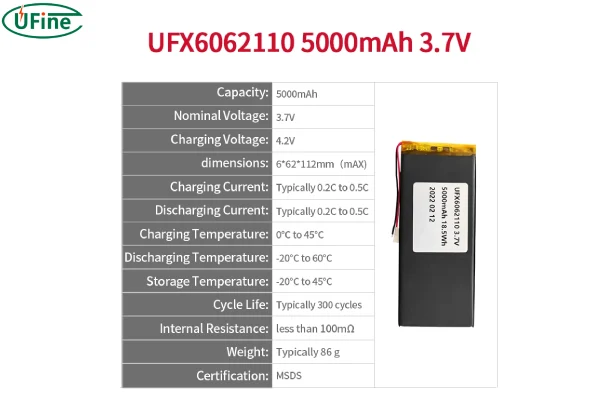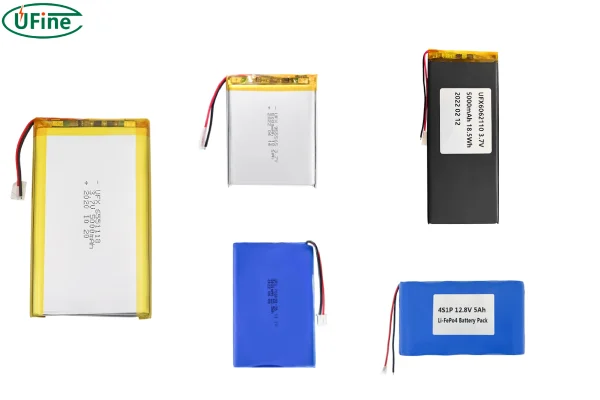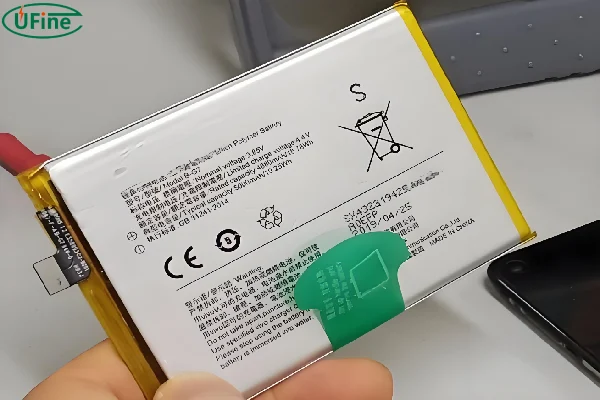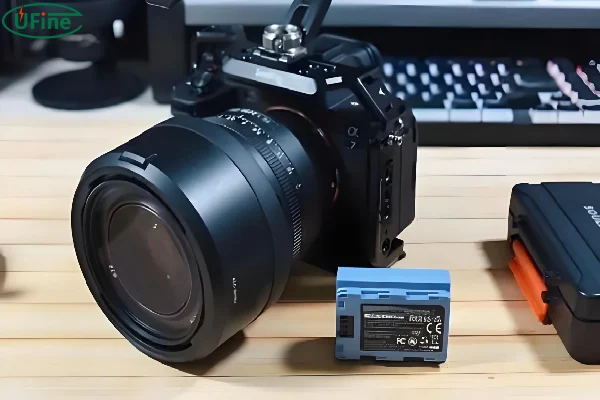
- Part 1. What is a 5000 mAh battery?
- Part 2. Voltage of a 5000 mAh battery
- Part 3. Comparison of different types of 5000 mAh batteries
- Part 4. What's the 5000 mah battery life?
- Part 5. How long does it take to charge a 5000 mAh battery?
- Part 6. Where are 5000 mAh batteries used?
- Part 7. Is 5000 mah battery good?
- Part 8. How to choose the best 5000 mAh battery?
- Part 9. Where to buy a 5000 mAh battery?
Part 1. What is a 5000 mAh battery?

A 5000 mAh battery is a powerhouse when it comes to keeping your devices running. The term “mAh” stands for milliampere-hour, which measures how much electrical charge a battery can hold. In this case, a 5000 mAh battery can deliver a steady 5000 milliamps of current for one hour before it completely drains. It’s like the fuel tank of your smartphone or tablet, dictating how long you can keep chugging along without needing a recharge.
Part 2. Voltage of a 5000 mAh battery
The voltage type of a 5000 mAh battery depends on its chemistry and application. Here are the most common types:
-
Lithium-Ion Batteries:
- Nominal Voltage: 3.6V or 3.7V
- Fully Charged Voltage: 4.2V
- Commonly used in smartphones, power banks, and drones.
-
Lithium Iron Phosphate (LiFePO4) Batteries:
- Nominal Voltage: 3.2V
- Fully Charged Voltage: 3.65V
- Known for stability and safety, often used in solar energy systems and electric vehicles.
-
Nickel-Metal Hydride (NiMH) Batteries:
- Nominal Voltage: 1.2V per cell (series configurations increase overall voltage).
- Typically used in devices requiring moderate energy density, such as older cordless tools and AA battery replacements.
Part 3. Comparison of different types of 5000 mAh batteries
When considering a 5000 mAh battery, it’s important to understand the different types available. Each type comes with its own set of features and benefits, making them suitable for various power needs and applications. Here’s a look at the most common types:
1.Lithium-Ion (Li-Ion) Batteries
Lithium-Ion batteries are the go-to for many modern devices. You’ll find these in smartphones, laptops, and many portable gadgets.
- Pros:
- High Energy Density: They store more energy in a smaller space.
- Longer Lifespan: They generally last longer compared to other types.
- Lightweight: Great for portable devices.
- Cons:
- Cost: More expensive than other options.
- Safety Concerns: Potential risk of overheating and exploding if damaged.
2. Lithium Polymer (LiPo) Batteries
Lithium Polymer batteries are a newer variation in the Lithium family. They are popular in drones, RC cars, and some high-end smartphones.
- Pros:
- Flexible Form Factor: Can be molded into different shapes and sizes.
- Light and Thin: Even lighter than Li-Ion batteries.
- Stable: Less prone to leaking and can be safer.
- Cons:
- Cost: Generally more expensive than Li-Ion.
- Life Cycle: Tend to have a shorter lifespan.
3. Nickel-Metal Hydride (NiMH) Batteries
Nickel-Metal Hydride batteries used to be all the rage before Lithium-based batteries took over. They are still found in older electronics, rechargeable AA/AAA batteries, and some power tools.
- Pros:
- Environmentally Friendly: Easier to recycle compared to Lithium batteries.
- Cost: Generally cheaper.
- Cons:
- Lower Energy Density: They don’t last as long on a single charge.
- Self-Discharge: Lose charge quicker when not in use.
4. Alkaline Batteries
While not typically 5000 mAh, it’s worth mentioning as they’re commonly used in household devices like remotes and flashlights.
- Pros:
- Availability: You can find them almost anywhere.
- Cost: Very inexpensive.
- Cons:
- Disposable: Not rechargeable.
- Lower Capacity: Won’t offer 5000 mAh in most cases.
5. Graphene Batteries
Graphene batteries are an emerging technology offering exciting possibilities. While still mostly in the experimental or early adoption stages, they promise to revolutionize the battery industry.
- Pros:
- High Capacity: Potentially hold more charge.
- Fast Charging: Can charge much quicker than traditional batteries.
- Cons:
- Availability: Not widely available yet.
- Cost: Likely to be expensive initially.
Part 4. What’s the 5000 mah battery life?
When someone sees that their device has a 5000 mAh battery, the immediate question on their mind is likely: “How long does this battery last?” The answer varies, depending on several factors. Let’s dive into the nitty-gritty details:
Factors Influencing Battery Life
-
Usage Patterns:
- For an average user doing light activities (like browsing the web, checking emails, or social media), a 5000 mAh battery might last about 2 days.
- Power users who frequently engage with heavy applications, like gaming, streaming videos, or multitasking, might find the battery lasting approximately one full day.
-
Screen-On Time:
- Screen brightness is a huge battery drainer. A brighter screen consumes more power.
- Resolution and refresh rate also impact battery life. A higher resolution or refresh rate demands more energy.
-
Network and Connectivity:
- Usage of mobile data, especially 4G or 5G, drains the battery faster than Wi-Fi.
- Bluetooth, GPS, and constant background syncing can chip away at battery reserves.
Power Consumption Estimations
- Video Streaming:
- Watching videos on platforms like YouTube can draw around 350 mA to 700 mA per hour.
- Gaming:
- High graphics games consume between 800 mA to 1200 mA per hour.
- Music Listening:
- Streaming music typically uses between 50 mA to 100 mA per hour.
- Standby:
- On standby, a device with a 5000 mAh battery might last several days, depending on background processes.
Charging Intervals
- Generally, users might find themselves charging their phone:
- Once every 2 days with moderate use.
- Daily with intensive use.
Battery Efficiency Tips
- Lowering screen brightness and disabling unused network services can extend battery life.
- Opting for battery-saving modes when not performing demanding tasks is beneficial.
- Closing unused apps running in the background helps keep the battery from draining quickly.
A 5000 mAh battery offers flexibility and reliability, making it a solid choice for those who rely heavily on their devices.
Part 5. How long does it take to charge a 5000 mAh battery?
The time required to charge a 5000 mAh battery depends on several factors, including the charging current, the charger’s efficiency, and the battery’s chemistry. Here’s a breakdown:
1. Charging Current
-
Standard Charge Rate (1C):
Charging at 1C means supplying a current equal to the battery’s capacity—in this case, 5A. At this rate, a fully depleted 5000 mAh battery will charge in approximately 1 hour. -
Lower Charge Rates (e.g., 0.5C):
Charging at 0.5C (2.5A) is gentler on the battery, reducing stress and prolonging its lifespan, but it will take 2 hours to charge fully. -
Trickle Charging (e.g., 0.1C):
At 0.1C (0.5A), it can take 10 hours or more to charge a 5000 mAh battery, often used for older NiMH or nickel-cadmium batteries.
2. Charger Efficiency
No charger is 100% efficient, and energy is lost as heat during charging. Efficiency is typically 80–90%, which can slightly increase charging times. For example, a charger with 85% efficiency may take 10–15% longer.
3. Battery Chemistry
-
Lithium-Ion Batteries:
Typically, these take 1–2 hours to charge using a compatible fast charger. They may charge faster up to 80% capacity and then slow down to protect the battery. -
Lithium Iron Phosphate (LiFePO4):
These batteries have a slightly longer charging time due to their chemistry, usually taking 2–3 hours. -
Nickel-Metal Hydride (NiMH):
NiMH batteries charge at slower rates and may take 4–6 hours or more for a 5000 mAh battery, depending on the charger used.
4. Charger Specifications
Using a high-quality charger with adjustable current settings can optimize charging time while ensuring safety. Always use a charger designed specifically for your battery’s chemistry and voltage to avoid overcharging or damage.
Part 6. Where are 5000 mAh batteries used?
5000 mAh batteries are popular with many gadgets and devices. Here’s where folks commonly see them in action:
Smartphones & Tablets
- High-End Smartphones: Modern flagships need more juice. A 5000 mAh battery keeps them running all day without a hitch.
- Tablets: Given their larger screens and more intense usage, tablets with these batteries ensure users can binge-watch or work without constantly seeking out a charger.
Gaming Devices
- Portable Gaming Consoles: Gamers hate interruptions. Portable consoles featuring 5000 mAh batteries let players enjoy extended gaming sessions.
- Gaming Smartphones: Hardcore mobile gaming calls for serious power. These specialized phones often come equipped with hefty batteries to support high-demand games.
Wearable Tech
- Smartwatches: Smartwatches with bigger batteries last longer, reducing the need for frequent recharges, and letting users enjoy fitness tracking, notifications, and more.
Cameras
- Digital Cameras: Photographers need reliability. Cameras equipped with larger batteries can shoot more photos and videos, crucial for events or long shoots.
- Action Cameras: These cameras, known for adventurous settings, rely on powerful batteries to capture all the action without missing a beat.
Personal Health Devices
- Fitness Trackers: Tracking steps, heart rate, sleep, and more benefits from extended battery life, ensuring nothing gets missed.
- Medical Devices: Devices that monitor health continuously, like glucose meters, often come with bigger batteries for reliable, uninterrupted service.
Home Automation
- Smart Home Devices: Things like smart doorbells, security cameras, and other smart home gadgets that need continuous power use 5000 mAh batteries to stay active longer.
Travel Gadgets
- Portable Power Banks: These essential travel companions often use large batteries to recharge multiple devices multiple times.
- GPS Devices: A reliable GPS device shouldn’t die in the middle of nowhere, which is why a strong battery is a must.
Miscellaneous
- Bluetooth Speakers: For a day at the beach or a picnic, speakers with larger batteries are essential to keep the tunes going.
- Drones: These gadgets demand significant power for flights, making 5000 mAh batteries a frequent choice.
There’s a vast array of tech relying on these powerful batteries, providing more convenience and usability for power users everywhere.
Part 7. Is 5000 mah battery good?
A bunch of reasons make 5000 mAh batteries a hot pick. Let’s dive right in:
-
Extended Battery Life:
- Power users need their devices to last throughout the day, even under heavy usage.
- 5000 mAh batteries provide that much-needed extra juice, meaning users don’t have to be glued to a charger.
-
Multi-tasking Capabilities:
- With more power, users can run several apps and processes without worrying about a quick drain.
- This is a significant advantage for gamers, streamers, and those who use their devices for both work and play.
-
Heavy Media Consumption:
- Watching videos, streaming music, and browsing social media can zap a battery quickly.
- A 5000 mAh battery ensures that these activities don’t force users to constantly reach for a charging cable.
-
Better User Experience:
- Users expect their devices to perform smoothly without interruptions.
- A larger battery helps keep the performance consistent, enhancing overall satisfaction.
-
Emergencies and Travel:
- When traveling or stuck in a situation without access to a power outlet, a bigger battery can be a lifesaver.
- It gives peace of mind knowing there’s enough backup to get through unexpected delays.
-
Power Efficiency:
- Modern processors and software updates have become more power-hungry.
- A 5000 mAh battery keeps up with these advancements, ensuring the device runs efficiently without frequent recharges.
-
Wireless and Fast Charging:
- These batteries often support advanced charging methods, providing quicker and more convenient ways to top up.
- Users get back to using their devices faster with minimal downtime.
Those who rely heavily on their smartphones or tablets will find these points especially relevant. A 5000 mAh battery is not just a luxury; it’s becoming a necessity for the power-hungry user of today.
See? It’s no wonder these batteries are such a big deal. They meet the growing demands of today’s tech-savvy crowd.
Part 8. How to choose the best 5000 mAh battery?
Choosing the best 5000 mAh battery can seem overwhelming, but it’s all about knowing what really matters. Here are key factors to consider:
Compatibility
- Device Compatibility: Ensure the battery is compatible with the specific device.
- Voltage Requirements: Check that the voltage matches the device’s requirements.
Quality and Brand
- Reputable Brands: Opt for well-known brands for reliability.
- Customer Reviews: Look at user reviews and ratings to gauge performance.
Capacity and Performance
- True Capacity: Verify the actual capacity against the advertised capacity.
- Consistency: Check if the battery can consistently deliver power without significant drops.
Safety Features
- Overcharge Protection: Ensure it has safeguard mechanisms against overcharging.
- Temperature Control: Check for features that manage temperature to prevent overheating.
Charging Speed
- Fast Charging: Choose batteries that support fast charging if your device allows it.
- Input/Output Efficiency: Look for batteries with high input/output efficiency ratings.
Build and Design
- Durability: Pick a battery with a robust build and high-quality materials.
- Portability: Consider the size and weight, especially if the battery will be used on-the-go.
Cost
- Budget: Determine the budget and find the best option within that range.
- Value: Evaluate if the features justify the price.
Additional Features
- LED Indicators: Features like LED indicators can show the charge level at a glance.
- Extras: Some batteries come with additional ports or built-in cables.
Warranty and Support
- Warranty Period: Longer warranties can indicate a manufacturer’s confidence in their product.
- Customer Support: Good customer support can be essential if issues arise.
By keeping these factors in mind, anyone can make a well-informed choice in selecting the best 5000 mAh battery suited to their needs.
Part 9. Where to buy a 5000 mAh battery?
So, you’ve decided you want to power up with a 5000 mAh battery, huh? Awesome choice! Now, the next step is figuring out where to get one. Luckily, finding a high-quality 5000 mAh battery is easier than you might think. Here are some of the best places to start your search.
1. Online Retailers
Online shopping is a no-brainer. It’s convenient, fast, and you can browse tons of options from the comfort of your couch. Some great places to start include:
- Amazon: The king of online shopping has a vast selection of 5000 mAh batteries from various brands. Check for reliable sellers and read user reviews.
- eBay: Find both new and used batteries, often at competitive prices. Just make sure to check seller ratings!
- Newegg: Primarily known for tech products, Newegg has a solid range of batteries. They often have detailed specs and user reviews.
2. Retail Stores
If you’re the kind of person who prefers to see a product before buying, hitting up a retail store could be your best bet.
- Best Buy: Known for tech gadgets, Best Buy offers a variety of batteries. Plus, you can ask sales associates for recommendations.
- Walmart: Affordable prices and a wide selection make Walmart a reliable option. You can also order online and pick it up at the store.
- Target: Another retail giant, Target has various brands to choose from and often runs sales.
3. Specialty Stores
For those looking for something a bit more specific or higher quality, specialty stores are the way to go.
- Battery Stores: Stores like Batteries Plus Bulbs specialize in, you guessed it, batteries. The staff usually know their stuff and can offer valuable advice.
- Electronics Stores: Local or chain electronics shops, like Micro Center, often carry high-capacity batteries.
4. Carrier Stores
Sometimes it’s better to go straight to the source. If you’re looking for a battery for your smartphone, consider visiting:
- AT&T, Verizon, or T-Mobile Stores: Carrier stores can help you find the right battery for your specific phone model.
5. Direct from Manufacturers
Getting a battery straight from the manufacturer ensures you’re getting an authentic product.
- Samsung, Ufine Battery, and other brands: Check the official websites or physical stores of these brands.
Related Tags:
More Articles

Battery Load Test: A Comprehensive Guide
Step-by-step battery load test guide for car, solar & industrial use. Learn how to load test a battery, interpret voltage charts, and avoid common mistakes.
The Comprehensive Guide to Battery Balancing and Battery Balancer
Discover how battery balancers improve lithium battery performance, lifespan, and safety. Learn types, functions, and tips to choose the right balancer.
What Is the Best Voltage for a Chainsaw Battery?
Compare 12V-80V chainsaw batteries for light pruning, medium firewood, and professional cutting. See best battery chainsaw with runtime charts and safety tips.
Lithium VS. Alkaline Batteries: A Comprehensive Comparison
Lithium batteries last 3–7× longer than alkaline and perform better in cold weather. Compare lifespan, cost, safety, and best uses to choose the right battery.
Comparing Lithium-Sulfur and Lithium-Ion Batteries: Which is Right for You?
Compare lithium-sulfur (Li-S) and lithium-ion batteries on energy, lifespan, cost, safety, and applications. Best choice for drones, EVs, and electronics.





